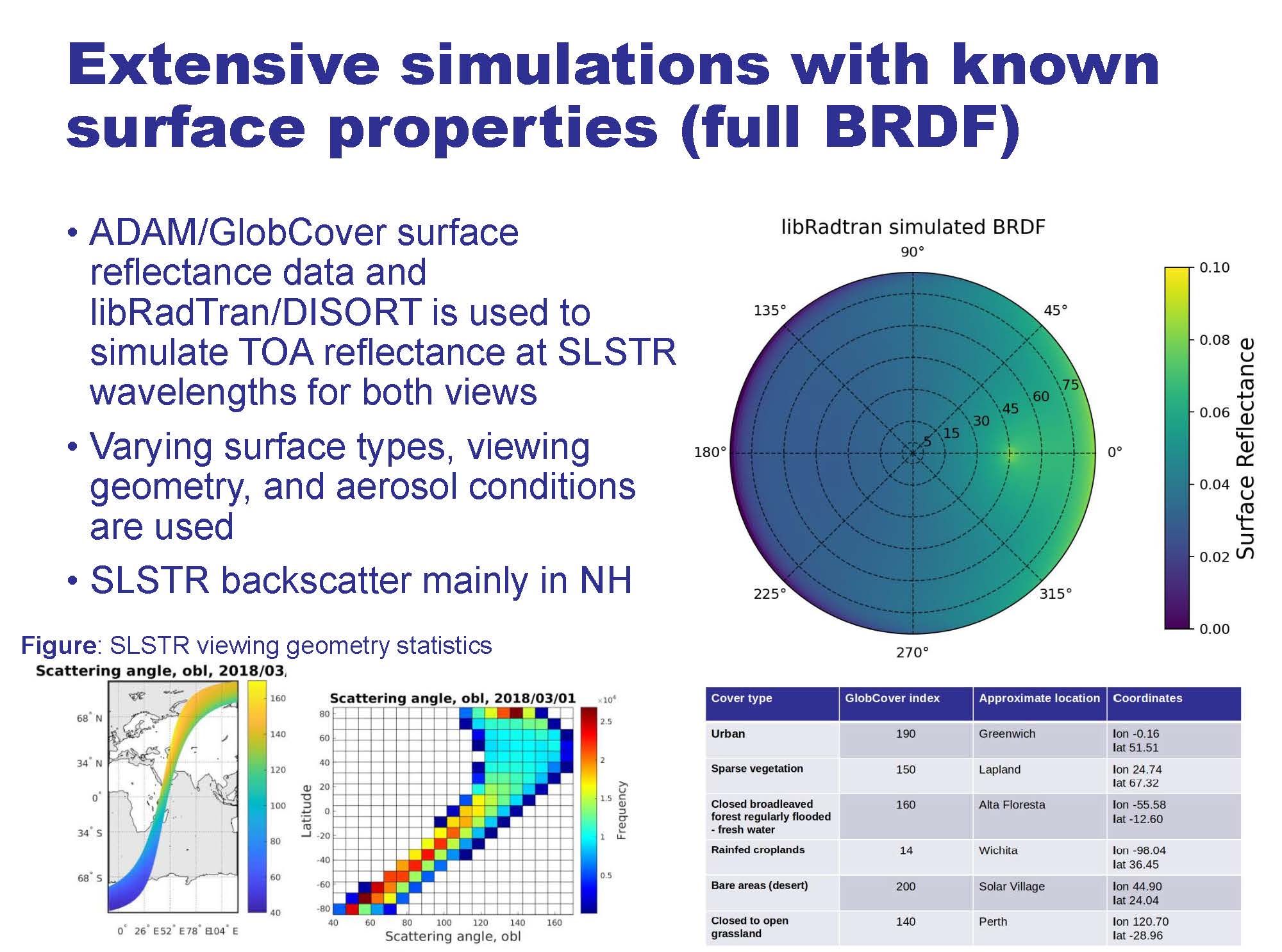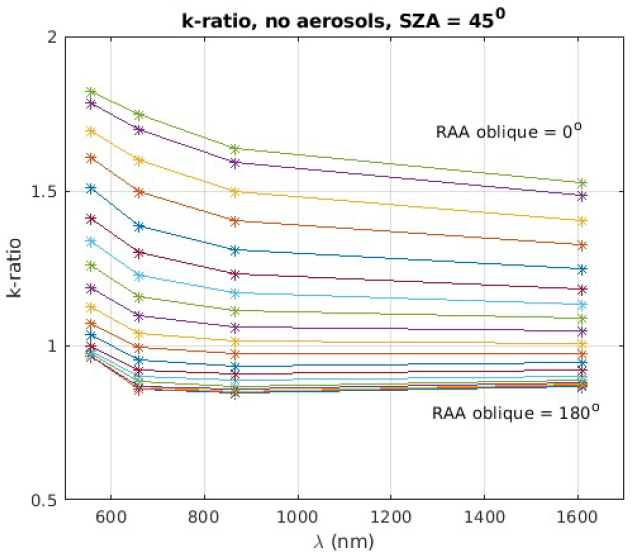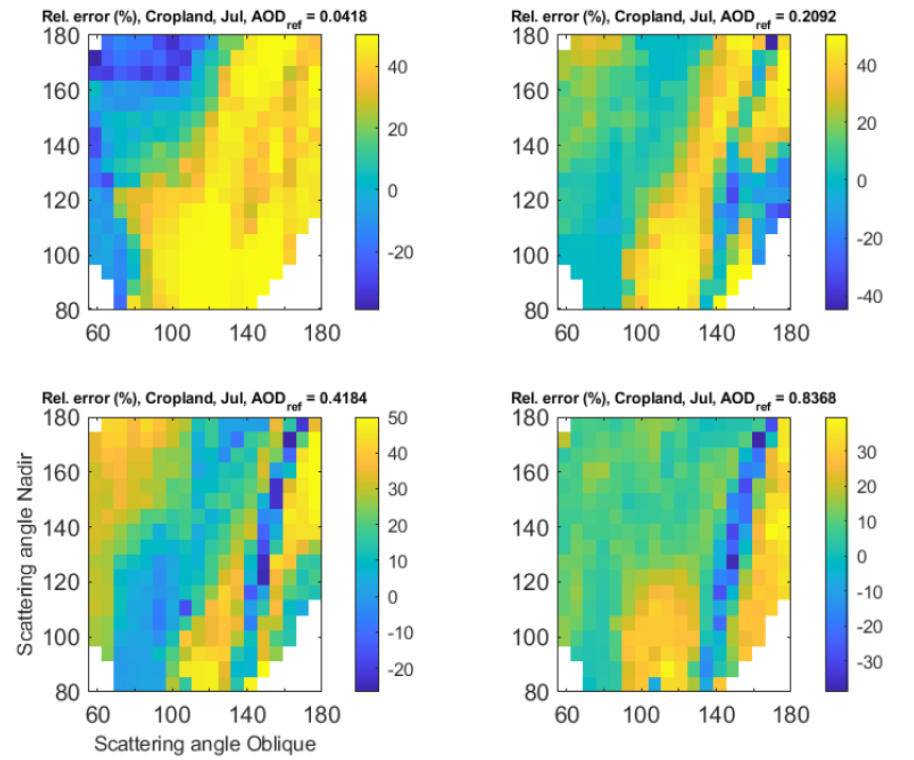16 February 2023
29 September 2021
Atmospheric aerosols are small solid or liquid particles suspended in the air. They are not only important for climate, but also because they influence local meteorology, due to their effects on cloud formation and associated albedo, and degrade air quality, leading to millions of premature deaths each year
To retrieve information on atmospheric aerosols from satellite-based sensors, the whole atmosphere-Earth system needs to be taken into account, i.e. upwelling radiation from the Earth surface due to (sub-) surface reflection and reflection by atmospheric constituents: gases, aerosols and clouds. AOD retrieval requires a performant cloud filtering, an effective separation of atmospheric and surface contributions to the reflection observed at the top of the atmosphere (TOA), and good prior information on particle properties.
Retrieval from a dual-view sensor like the Copernicus Sentinel-3 Sea and Land Surface Temperature (SLSTR) is of particular interest, as the limited multi-viewing and the lack of blue channels lead to a heterogeneous spatial distribution of the geometry information content and, hence, the capability to separate aerosol and surface scattering with or without prior surface knowledge. SLSTR differs in many ways from its Along Track Scanning Radiometers (A)ATSR predecessors: the dual-view orientation was rotated by 180 deg, the swath widths of both nadir and oblique views were extended, and a new Short Wave Infra Red (SWIR) channel was added at 2.25µm.
In the frame of the European Commission (EC) Copernicus programme, EUMETSAT has responsibility for the development, maintenance, validation and evolution of the operational Copernicus Sentinel-3 Near Real Time (NRT &mdash < 3h) Aerosol processor. In order to characterise and fully understand the benefits, but also the challenges, of retrieving aerosol information from SLSTR, this study was placed with the Finnish Meteorological Institute (FMI). The original FMI dual view algorithm (ADV) was developed for the Along Track Scanning Radiometers (ATSR) and here the adaptation of ADV to SLSTR is called SDV.
Objectives
The objective of this study was to characterise andquantify the capabilities of the Sentinel-3 SLSTR measurement and associated physics information for the purpose of a mature AOD product globally, compliant with scientific NRT requirements. For that purpose, the idea was to use a reference algorithm with demonstrative capabilities for aerosol dual-view radiometers and with a suitable retrieval configuration with respect to SLSTR. To this end, the mature SDV algorithm was exercised with SLSTR data and the resulting retrieval parameter, mainly AOD at 550nm (AOD550), was investigated in-depth using state-of-the-art radiative transfer simulations combining aerosols and surfaces, reference measurements from the AERONET network, and by comparison with the most commonly used satellite AOD product, i.e. the MODIS-Terra C6.1 merged Dark Target Deep Blue AOD product (the MODIS-Terra observations are close in time to the SLSTR observations). Retrieval errors were characterised as a function of dual-view geometry, surface type, wind speed and white cap parameterisations over oceans.
Overview
The project kicked-off in 2019 and concluded in March 2021. FMI and EUMETSAT investigated the SLSTR aerosol retrieval challenges in various geophysics conditions by exploiting a state-of-the-art SLSTR simulated database, based on extensive Bidirectional Reflectance Distribution Function (BRDF) surface treatment and atmospheric radiative transfer calculations (see Figure 1). For BRFF, the European Space Agency (ESA) ADAM/GlobCover data and the libradtran/DISORT radiative transfer model was used. It included all surface types, aerosol conditions, and extensive viewing geometry array (solar, viewing, and azimuth) to cover the comprehensive range of SLSTR scattering angles.
The main points investigated were:
- Pros. and Cons of 'only' two views for aerosol and land surface decoupling. Implicitly, the SLSTR v AATSR dual-view geometry acquisition was deduced in terms of impacts on different regions.
- Impacts of spectral and dual-view radiance calibration errors.
- Land AOD retrieval validation as a function of surface type (bare soils, high vegetation, urban/hybrid soils) and dual-view geometry.
- Possibilities to parameterise land spectral surface reflectance in the spectral ratio from SWIR to green.
- Ocean AOD retrieval validation as a function of wind speed and various white cap parameterisations.
The main lessons learned with respect to SLSTR were:
- The TOA aerosol signal is firstly (but not only) constrained by Relative Azimuth Angle (RZA) in the oblique view and the range of scattering angle between both nadir and oblique views. Typically, its relative contribution, compared to that from the TOA surface, decreases with increasing RZA in the oblique view (see Figure 2).
Figure 2: Illustration of the relative contribution of aerosol signal of the total Top Of the Atmosphere (TOA) reflectance, based on simulations with variable Aerosol Optical Depth (AOD), and two different SLSTR oblique view geometry, left: low scattering angle, right: high scattering angle. - The surface signal largely increases in case of backscatter geometry: e.g. high scattering angle in the oblique or nadir views. It also presents a high spectral signature from SWIR to green in the BRDF which can be more or less similar to the spectral signature of the aerosol phase function. This illustrates the similarity in spectral signature between both aerosol & surface geometries and hence the lower information content from a dual-view sensor in such a geometry condition (see Figure 3).
Figure 3: Spectral variability of the oblique/nadir TOA reflectance ratio (“k-ratio) from atmospheric-free simulations, as a function of oblique view Relative Azimuth Angle (RAA). - The difficulty of AOD retrieval from a dual-view sensor, and, hence, its associated absolute error (regardless of its sign), is a function of both scattering angles (nadir and oblique) and how they combine over a given location/time/day, and can be mapped as a function of latitude, longitude and Earth inclination (see Figure 4). It should always be reported first as a function of geometry.
Figure 4: Estimated relative AOD error (%) as a 2D function (scattering angles in nadir and oblique views). Simulations with cropland surface type, AOD(550nm) = 0.4, and via the FMI SLSTR aerosol retrieval algorithm. - The sensitivity of aerosol retrieval to L1B calibration errors increases significantly in case of complex geometry (high dominance of backscatter geometry on nadir or oblique view). It also dominates in case of high dust load over ocean surfaces. The angular and spectral consistencies of calibration in both views are also important.
- Various white cap formulations were tested with different dependencies on Sea Surface Temperature (SST) and wind speed. Overall, at low and medium wind speed, the impacts on AOD over the southern oceans remain very small, probably within the AOD Ocean uncertainty.
Details of the analysis are available in the final reports (see Documents tab below), and have been of great benefit to the ongoing evolutions of the Copernicus Sentinel-3 SLSTR NRT aerosol product from EUMETSAT.







